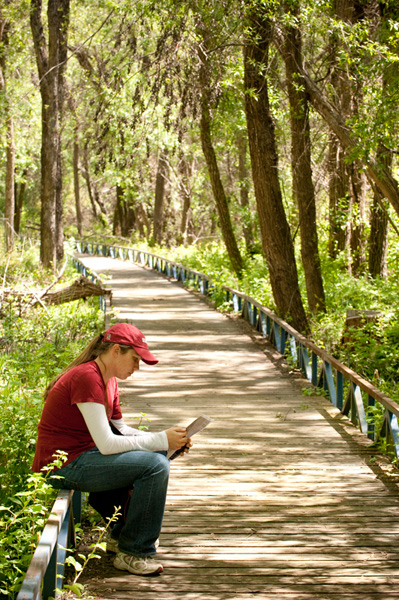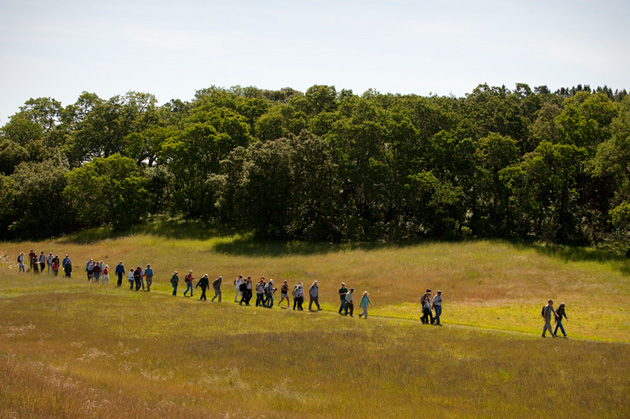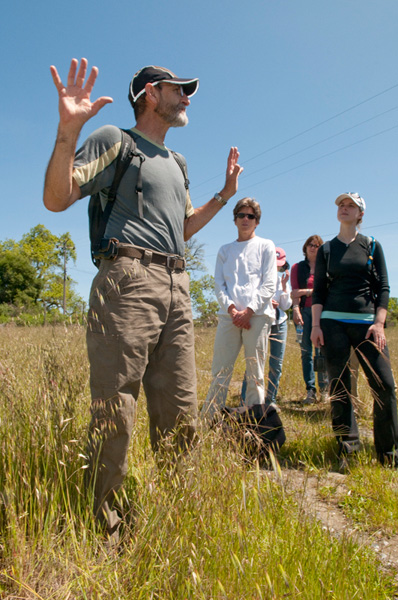While walking the Farm, hikers learn about Stanford's role in dealing with climate change
Pastoral perfection was tempered by evidence of climate change as Stanford faculty and staffers explained how global warming is affecting areas of campus and what researchers are doing about it.
BY ADAM GORLICK
Conditions seemed perfect Saturday on Jasper Ridge.
The mid-morning sun was finally warming a group of hikers who set out for the spot from Stanford's main campus at 6:15 a.m. The wind was calm. Purple, yellow and orange wildflowers dotted a field of wispy serpentine grass overlooking the San Francisco Bay.
But something was missing: the Bay checkerspot butterfly.
Undermining this pastoral perfection on an open swath of Stanford's biological preserve is the creeping onset of global warming. Erratic rainfalls beginning in the 1970s upset the butterflies' life cycles, killing many of them and forcing the survivors from one spot of the 1,189-acre preserve to another. Now, they're all gone.
"The butterflies were getting yanked around because there weren't enough average years of rainfall," said biology Professor Carol Boggs. "Too much or too little rain is no good. They need Goldilocks conditions, and they didn't have them here anymore."
Boggs was sharing the ecological lesson with 42 students, researchers and tagalongs on the fourth "Walk the Farm," an annual daylong hike across Stanford's property that follows a different route each year and explores various global themes by showing how the university fits into that bigger picture.
This year's 21-mile trek organized by the Bill Lane Center for the American West focused not only on the problems of climate change but also on the ways that Stanford faculty and staff are dealing with it.
Boggs wasn't simply bemoaning the problems that pushed the Bay checkerspots onto the federal list of threatened species. She also talked about the genetic research she's doing that it's hoped will help to reintroduce the butterflies to Jasper Ridge.
About a dozen other stops along the hike featured speakers who explained projects under way at Stanford and the Bay Area to address water, energy and food conservation and to improve the environment.
"Stanford is unique among universities in that it has such a sizable property with so much going on," said David Kennedy, a historian and faculty co-director of the Bill Lane Center, who led the walk with Jon Christensen, the center's executive director. "There's an industrial park, farm land, a shopping center and biological preserve in addition to everything else you think of when you think of the university. It lends itself to studying a whole range of issues of land use."

Koree Blyleven examined a map of the route while the "Walk The Farm" group stopped in a shady spot in Jasper Ridge Biological Preserve.
About nine miles from a wooded area on Jasper Ridge where biologist Bill Anderegg talked about the impact of climate change on bird diversity, Stanford sustainability coordinator Jiffy Vermylen stood on the main campus giving a rundown of the cutting-edge technology planned for the facility that supplies the university's heat and electricity, and the Business School's new Knight Management Center.
And not far from Boggs' presentation on butterflies, Chris Field - one of the scientists on the United Nations International Panel on Climate Change who shared the 2007 Nobel Peace Prize with former Vice President Al Gore - showed off an experiment he's running to figure out the best way to restore grasslands hurt by climate change.
Field is dosing 150 plots, each measuring about 9 square feet, with a different combination of the four elements of global warming: carbon dioxide, nitrogen, heat and increased precipitation. Each plot makes up a complete ecosystem.
"We're trying to project what will happen to the grasslands 100 years in the future," Field said.
The results from the experiment - now in its 11th year - will teach scientists how to "take responsibility and become better stewards" of the environment, he said.
The nearly 12-hour walk that started and ended at the Jerry Yang and Akiko Yamazaki Environment and Energy Building went over the Dish and passed by Felt Reservoir (which is used to irrigate Stanford's athletic fields and other grounds) before climbing to Jasper Ridge.
The group of hikers shrank to 29 after lunch on the preserve. Those who continued crossed the Searsville Reservoir before hearing about environmental conservation efforts and energy consumption at the 2-mile-long linear accelerator at the SLAC National Accelerator Laboratory.
From SLAC, the hikers walked along Sand Hill Road onto the university's main campus, where speakers talked about climate change and human health, the university's efforts to make students more aware of the connection between their meals and the environment, and a new "green" dorm slated for construction.
"Being a senior, I've seen most of this campus and I've interacted with lots of researchers," Cara Brook, an Earth systems major, said somewhere around the 20-mile mark. "But this hike really gives you a sense of the wealth of Stanford's habitat and the experience of the people who are part of the university."



